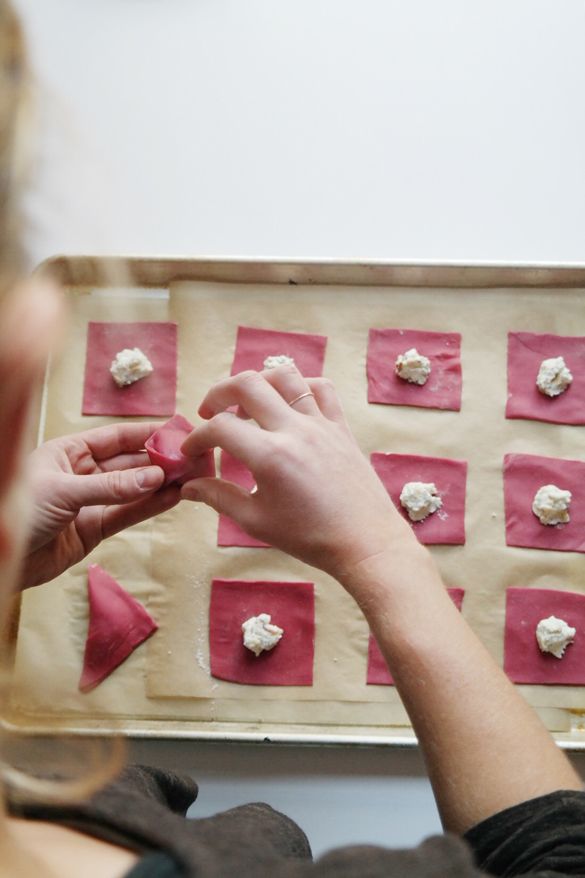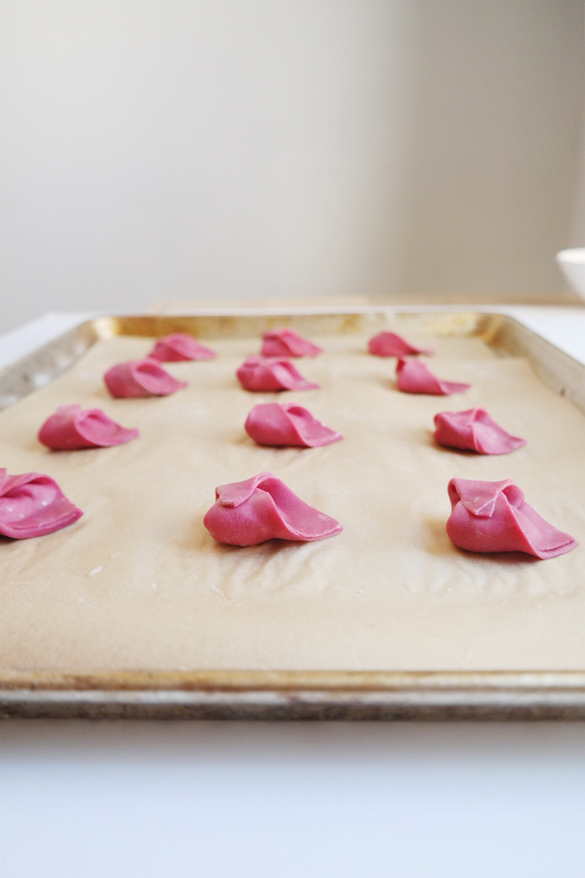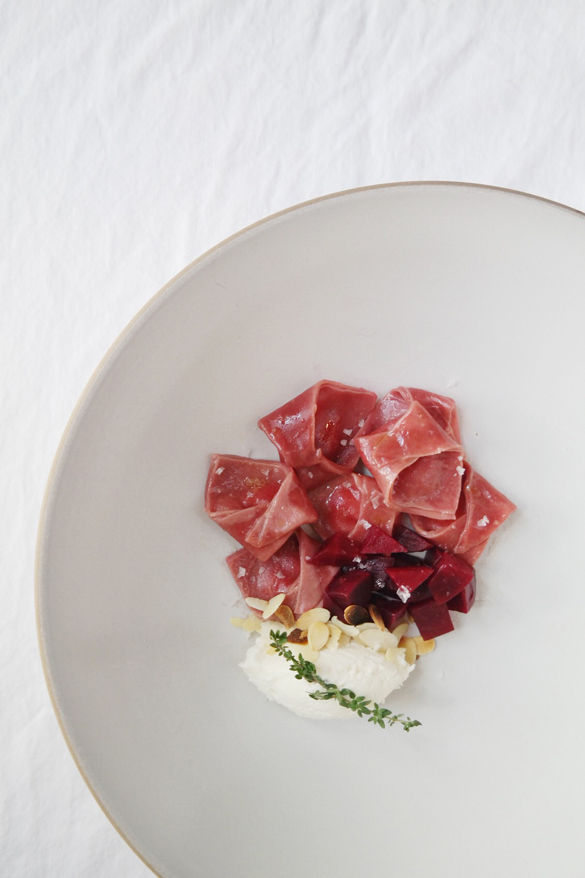
Beet Tortellini
In Level 2 of the professional culinary arts program, we made pasta. I remember being surprised by how simple it was to prepare, and how special it felt to eat. Given a little love and patience, it was remarkable to me what eggs, flour, and olive oil could become.
That day, we made a few different pasta doughs — one basic, that we used to create ravioli and tortellini, and one that we flavored with spinach for a lasagna. While both were delicious, I was especially drawn to the spinach pasta and its speckled vivid green color. Feeling inspired, I asked our chef if other foods could dye pasta dough so brilliantly, to which he replied, “Beets would be nice.”
I have always loved the dramatic color of beets – that deep, magnificent purple hue that seems more fitting of a jewel than of a vegetable. The idea of using them to color a pasta dough made perfect sense.
I went to work on developing a recipe – one that would be simple to prepare, but just as special to eat. The result is a four ingredient pasta dough, dyed a soft pink from pureed beets, and filled with creamy ricotta cheese, toasted almonds, and bright, lemony thyme leaves. The dish is finished with the same ingredients that fill the tortellini, along with a generous drizzle of fruity olive oil. Thank you, Chef Dominique, for the inspiration.

For the pasta dough:
- 4 medium to large beets, greens removed and peeled [some will be reserved for garnish]
- 1 egg
- 2 egg yolks
- 3 tablespoons extra virgin olive oil
- 3 cups all purpose flour, plus more for dusting
Yield: 1 1/2 pounds of dough
For the tortellini filling:
- 1 cup ricotta cheese
- 1/4 cup sliced almonds, toasted in a dry pan until golden
- 2 teaspoons fresh thyme leaves, minced
- 1/4 teaspoon coarse salt
- freshly ground black pepper
For garnish:
- extra virgin olive oil
- fresh thyme leaves
- flaked or coarse salt
- sliced almonds, toasted
- ricotta cheese
- reserved beets from pasta dough
Cut the peeled beets into large chunks and add to a stockpot. Fill with enough water to cover the beets by 1/2 of an inch. Bring to a boil, and reduce to a simmer. Cook until beets are tender when pierced with a fork, about 40-45 minutes. Remove beets and reserve the water for cooking the pasta later.
Reserve about half of the beets and set aside [these will be used for garnish when plating]. Place the other half in a food processor and blend until completely smooth. Transfer to a bowl and allow to cool completely.
Once cool, add ¾ cup of the beet puree, egg, egg yolks, and olive oil to a medium bowl. Whisk gently until everything is completely combined.
Add the flour to a large work surface and form a mound. Make a well in the center, and carefully pour the beet and egg mixture into it (making sure it is completely surrounded by the flour). Using a fork, slowly incorporate the flour into the wet mixture, starting with the inner edges and working outward, until a shaggy, sticky dough starts to form. At this point, knead the dough for about 8-10 minutes, until completely smooth, dusting your work surface lightly with flour if it sticks [be careful not to add too much flour, as it will make the dough too dry]. Once your dough is completely smooth, wrap it tightly in plastic and allow to rest at room temperature for at least 45 minutes.
Once rested, divide the dough into four equal parts. Working with one section of dough at a time, run through a pasta roller, starting on the widest setting. Fold the dough in half, dust lightly in flour, and run through the widest setting once more. Change to the next setting and run the dough through again. Continue to run the dough through each setting one time, dusting the outside of the dough as needed, ending with the lowest, thinnest setting.

Alternatively, if you do not have a pasta roller, you can roll the dough by hand on a floured work surface, moving the dough frequently to avoid sticking, until it is about 1 – 2 millimeters thick. Work with very small portions, and keep in mind that it will take some patience and muscle.
Transfer the rolled dough to a parchment lined sheet pan, and cover loosely with plastic wrap. Once you have filled the pan with one layer of dough, cover with another piece of plastic wrap and continue to layer the dough, until you’ve finished rolling.
To form the tortellini, cut the rolled dough into 2 1/2 to 3 inch squares and transfer back to the parchment lined sheet pan. Cover with plastic wrap while you prepare the filling.

For the filling: in a medium bowl, mix together the ricotta, almonds, thyme, salt and pepper. Place about 1 teaspoon of filling in the center of each square of dough. Working with one square at a time, wet your finger with water and moisten the two adjacent sides of the square. Fold the square in half so that two opposite points meet and form a triangle, making sure to press the dry sides to the moistened sides. Press the sides to seal. Moisten the two far points of the triangle and bring them together, overlapping, to form a tortellini shape. Press together to seal. Repeat with the rest of the tortellini. Cover with plastic wrap until ready to cook to avoid them drying out. About 10 tortellini per person should be enough – any extra tortellini can be frozen on a separate sheet pan until hardened and then kept in a sealed container. Frozen tortellini can be placed directly into boiling water to cook, just add a few extra minutes of cooking time.
To cook: bring a large stockpot of water to a boil over high heat (you can include the reserved beet water for additional color and flavor). Season with salt. Add the tortellini and cook until just al dente [about 2 – 3 minutes]. Tortellini will float as they finish cooking. Drain and toss immediately with a drizzle of extra virgin olive oil.
To plate: arrange the tortellini on a plate and drizzle with additional extra virgin olive oil. Sprinkle with fresh thyme leaves, coarse salt, and toasted almonds. Serve each plate with a spoonful of ricotta cheese and the reserved cooked beets.
By JuliaJohnson,
Professional Culinary Arts student
Julia Johnson graduated from the International Culinary Center (ICC), founded as The French Culinary Institute (FCI). In 2020, ICE and ICC came together on one strong and dynamic national platform at ICE's campuses in New York City and Los Angeles. ICC’s culinary education legacy lives on at ICE, where you can explore your own future in food.


Add new comment